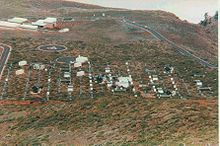High Energy Gamma Ray Astronomy
- High Energy Gamma Ray Astronomy
-
High Energy Gamma Ray Astronomy (HEGRA) war ein Experiment zum Nachweis hochenergetischer Gammastrahlen von astronomischen Objekten.
HEGRA war von 1987 bis 2002 in 2200m Höhe am Roque-de-los-Muchachos-Observatorium auf der Kanareninsel La Palma in Betrieb. Mit verschiedenen Detektortypen zum Nachweis der Sekundärteilchen in Luftschauern und der von ihnen erzeugten Cherenkov-Strahlung war HEGRA im Bereich 0.5-10000 TeV empfindlich. Es gelang der Nachweis höchstenergetischer Gammastrahlen von verschiedenen Himmelsobjekten wie Supernovaüberresten und aktiven galaktischen Kernen.
HEGRA war eine Kollaboration von Instituten in Deutschland, Spanien und Armenien. Nachfolgeexperimente sind High Energy Stereoscopic System und MAGIC.
Weblinks
28.761666666667-17.890833333333
Kategorien: - Bodengebundenes Observatorium
- Bauwerk auf den Kanarischen Inseln
- Erbaut in den 1980er Jahren
- Wissenschaft und Forschung in Spanien
- La Palma
- Bildung und Forschung auf den Kanarischen Inseln
Wikimedia Foundation.
Schlagen Sie auch in anderen Wörterbüchern nach:
High Energy Gamma Ray Astronomy — HEGRA es el acrónimo del inglés High Energy Gamma Ray Astronomy o Astronomía de Rayos Gamma de Alta Energía. Fue un complejo de detectores que funcionó en el Observatorio del Roque de los Muchachos en la Isla de La Palma entre 1987 y 2002, año en … Wikipedia Español
Gamma-ray astronomy — is the astronomical study of the cosmos with gamma rays. Early history Long before experiments could detect gamma rays emitted by cosmic sources, scientists had known that the universe should be producing these photons. Work by Eugene Feenberg… … Wikipedia
High Energy — bezeichnet: eine Stilrichtung der Elektronischen Tanzmusik, siehe Hi NRG High Energy (Lied), Popsong von Evelyn Thomas (1984) Siehe auch: High Energy Astronomy Observatory, verschiedene Röntgenteleskope High Energy Gamma Ray Astronomy, Experiment … Deutsch Wikipedia
gamma-ray astronomy — /gam euh ray / the branch of astronomy that deals with the study of celestial objects by means of the gamma rays that come from them. [1960 1965] * * * Study of astronomical objects and phenomena that emit gamma rays. Gamma ray telescopes are… … Universalium
Ultra-high-energy cosmic ray — Unsolved problems in physics Why is it that some cosmic rays appear to possess energies that are theoretically too high? In high energy physics, an ultra high energy cosmic ray (UHECR) or extreme energy cosmic ray (EECR) is a cosmic ray with an… … Wikipedia
Gamma ray — Gamma rays (denoted as gamma;) are a form of electromagnetic radiation or light emission of frequencies produced by sub atomic particle interactions, such as electron positron annihilation or radioactive decay. Gamma rays are generally… … Wikipedia
High-energy astronomy — is the study of astronomical objects that release EM radiation of highly energetic wavelengths. It includes X ray astronomy, gamma ray astronomy, and extreme UV astronomy, as well as studies of neutrinos and cosmic rays. The physical study of… … Wikipedia
gamma-ray burster — ▪ astronomy any of a class of very distant objects responsible for intense, nonrepeating flashes of high energy gamma rays that appear unpredictably at arbitrary points in the sky at a rate of about one per day and typically last only… … Universalium
Gamma ray burst — [ GRB 990123 taken on January 23, 1999. The burst is seen as a bright dot denoted by a square on the left, with an enlarged cutout on the right. The object above it with the finger like filaments is the originating galaxy. This galaxy seems to be … Wikipedia
High Energy Astronomy Observatory 3 — The last of NASA s three High Energy Astronomy Observatories, HEAO 3 was launched 20 September 1979 on an Atlas Centaur launch vehicle, into a nearly circular, 43.6 degree inclination low Earth orbit with an initial perigee of 486.4 km.The normal … Wikipedia


